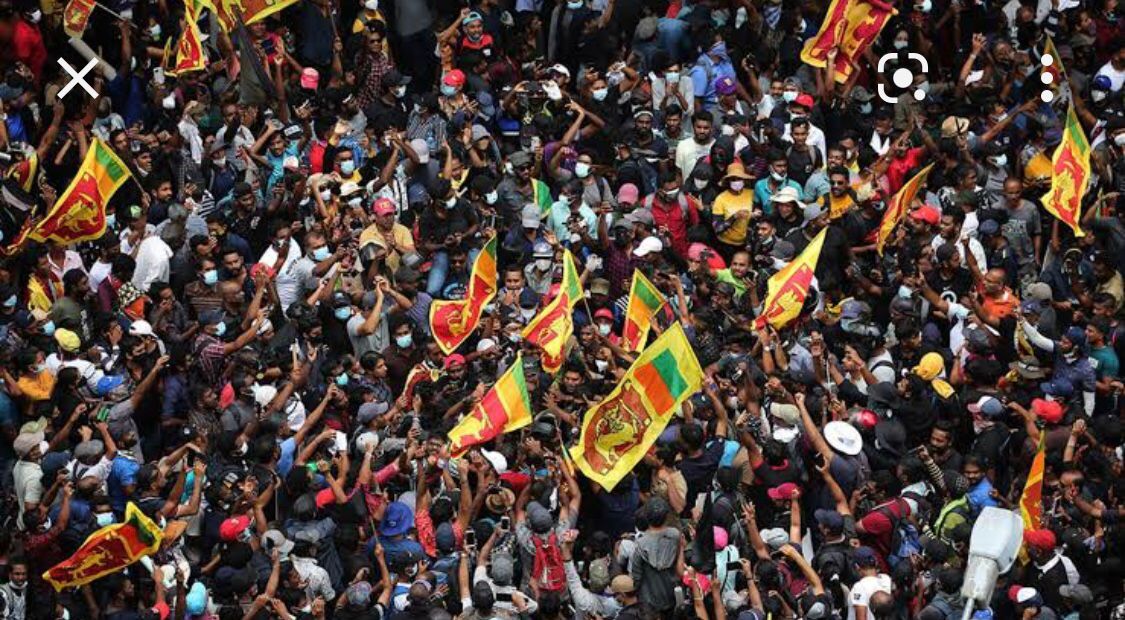
The frequently distressed nation is yet again amidst complete destruction, the island country has walked into what can be called as the worst economic crisis till date. Fuel shortages, scarcity of basic amenities, power cuts are frequently terrorizing the land, causing protests and anti- government sentiment to spread like wildfire across the country. Beneath the folds of crisis are a multiplicity of causes. The foundation of which had been laid down in as early as 2012. Since then, the island’s GDP growth has been on a steady decline.
Tourism contributed to almost 12- 13% of Sri Lanka’s economy and served as source of foreign currency for the country. The country’s heavy dependence on its tourism led to a series of adverse events, fuelling the decades’ worst economic downfall. By 2018, the island became one of the top tourist destinations, welcoming 2.3 million visitors and breaking all records before plunging to 0.17 million tourists in 2021. The Easter Bombings in 2019 claimed the lives of 269 civilians of which 45 were foreign nationals. A local terrorist group took responsibility for the attack, giving rise to anti- Muslim violence across the nation which was further aggravated through social media platforms like Facebook. As a result, the government blocked WhatsApp and Facebook as a measure to control the communal riots but the damage was already done, the instability along with the “Wuhan Virus” kept tourists away from the state. The 2022 Russian invasion of Ukraine has further exacerbated the calamity of the country as Sri Lanka’s tourism sector is heavily reliant upon these two nations as most of the tourist arrivals are from Russia and Ukraine. Consequently, the Ukrainian crisis has put a halt to the path of economic recovery of Sri Lanka with tourism sector greatly affected.
What we see today is a result of years of mismanagement in Sri Lanka. Exports exceeding the imports, trade deficit and budget deficit resulting in double debt, is the perfect recipe for disaster. The government’s response to the disaster is worse. Instead of narrowing down its shortfall, the country has expanded its’ loan by borrowing from several countries , bringing its’ debt to GDP ratio to 111%. Back in 2019, Gotabaya Rajapaksa campaigned for Presidential elections, promising deep tax cuts , not realising that it would cut down the country’s revenues drastically. In November 2019, Gotabaya was elected to office with almost 52% votes. He implemented the tax cuts, dwindling the revenues as anticipated.
The main motive behind the 15% tax cuts was to encourage people to spend and consume more, boosting the economic growth of the country. Just three months later, pandemic engulfed the world. Drastic steps were taken by the government to contain the virus. Consumers couldn’t purchase freely due to lockdown and other necessary restrictions, yet another cause for revenue losses and failure of the government policy.
Another example of the government’s failure was when Gotabaya Rajapaksa promised to covert Sri Lanka into a 100% organic state within ten years, acting upon this plan, the authorities implemented a nationwide ban on the importation and use of synthetic fertilizers and pesticides in April 2021 , forcing the country’s 2 million farmers to go organic. “Good for health”, said Gotabaya , justifying the overnight ban on fertilizers. This “Masterstroke” was criticized by many as it was just to cover the real reason which was to save the remnant foreign reserves that had decreased to USD 2.8 billion at the end of July 2021 from USD 7.5 billion when the administration took office in November 2019, according to the Central Bank of Sri Lanka.
The devastating impact of the agricultural reform surfaced quickly as farm outputs almost halved. The country was self sufficient and even exported white rice and tea but soon, their production fell by 50%, forcing the nation to import basic food items by June 2021 as it struggled to feed its own citizens. Approximately 450 million USD had to be spent to import rice within four months of implementing the policy. Such dire circumstances gave rise to food mafia on the island country as people began hoarding rice, sugar and pulses only to sell them at inflated prices in the black markets. To save up on the foreign reserves, the government banned import of luxury goods in July 2021, indicating that Sri Lankans needed to brace for the impending storm.
One of the most impactful causes for the unfolding of the crisis is the great foreign debt. Sri Lanka’s economy has been under the debt burden for several years and has now degraded to default levels. The Sinhalese Buddhist played an significant role in influencing the decision making of the country. Keeping the Buddhist sentiments In mind, the country turned from a pro-market approach to a welfare driven mode, investing heavily in the infrastructure sector. The nation preferred to grow closer to China rather than its immediate neighbour and used bilateral debt to fund infrastructural projects.
The island’s camaraderie with China costed it a fortune as it unknowingly walked itself into China’s debt trap diplomacy. In 2019, the debt to GDP ratio stood at 94% compared to 119% in 2021. Huge loans have been provided by China for various projects with strings attached, if Sri Lanka is unable to repay the loans, the structure or property developed will be taken over by the Chinese. All that could go wrong with the nation has gone wrong. Revenues from taxes fell, the agricultural sector diminished by 8%, the GDP has contracted, Sri Lanka isn’t receiving remittances from its citizens abroad, pandemic slowed down the economy and, to top it all, foreign entities were not ready to lend money. Sri Lanka had no choice but to turn to its neighbours. It received 200 million USD as financial aid from Bangladesh. On February 22, 2022 , India provided 500 million USD for fuel purchases, one billion USD credit line on March 17 along with a 400 million dollar currency swop. Despite the aid given, the state has requested for a further credit line of one billion USD from India.
China, on the other hand, has imparted 2.5 billion USD and has been requested to re- structure the debts. The value of Sri Lankan Rupees has fallen significantly causing imports to become even more expensive and inflation to soar. The currency was devalued by the President in March 2022 to encourage remittance and to qualify for fresh loans from the IMF. Moderation in monetary value reduced the peoples purchasing power. One USD was equivalent to 355.30 SLR compared to 202.92 SLR in January 2022, causing the Rupee to fall by almost 75% since the beginning of this year.
Inflation in the country is around 29.8% and is expected to increase further, food prices have risen by 30.20% . On 19th May 2022, Sri Lanka declared that it would be defaulting on all its’ external debt of approximately 51 billion USD that is expected to rise to 143 billion USD by 2026. The impact of the economic failure has been seen in almost every industry in Sri Lanka.
Frequent blackouts, food and fuel shortages have angered the citizens that took to the streets protesting with banners that read, “Go Gota Go”, expressing their anguish towards the government’s actions. Close to 500,000 Sri Lankans fell into poverty and lakhs are ready to pay hefty amounts to flee their own country that is facing a severe humanitarian crisis. The government declared state of emergency on April 1, 2022 which has been lifted only recently. Due to continuous protests, the whole cabinet along with the Prime Minister, Mahinda Rajapaksa , has stepped down while the President, stills rules the land. The newly appointed Prime Minister, Ranil Wickremesinghe stated that the crisis is “going to get worse before it gets better.”
The nation needs to take the support of the IMF to maintain its foreign reserves to a certain limit and the authorities should collaborate with economists around the world to devise a plan to pull the country out of the crisis. Though it might take years for the economy to recover, these actions must be taken to speed up the process of economic revival, otherwise the world might be looking at another Venezuela or Greece.
Nikita Jain
Welham Girls School.







